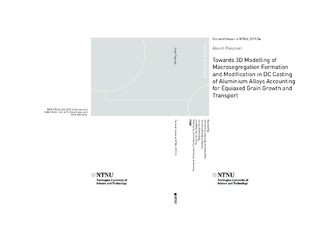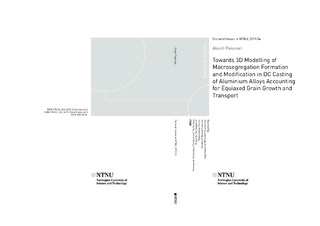| dc.contributor.advisor | M’Hamdi, Mohammed | |
| dc.contributor.advisor | Li, Yanjun | |
| dc.contributor.advisor | Ellingsen, Kjerstin | |
| dc.contributor.advisor | Combeau, Hervé | |
| dc.contributor.author | Pakanati, Akash | |
| dc.date.accessioned | 2019-04-11T13:28:39Z | |
| dc.date.available | 2019-04-11T13:28:39Z | |
| dc.date.issued | 2019 | |
| dc.identifier.isbn | 978-82-326-3673-0 ( | |
| dc.identifier.issn | 1503-8181 | |
| dc.identifier.uri | http://hdl.handle.net/11250/2594307 | |
| dc.description.abstract | Macrosegregation refers to the inhomogeneous distribution of solute elements at the scale of cast product. It is a severe defect affecting the quality of cast product produced through Direct Chill (DC) casting process. Several casting parameters and transport mechanisms such as shrinkage induced flow, natural convection and equiaxed grain motion contribute to macrosegregation formation. Of these, equiaxed grain motion and its interplay with other transport mechanisms leading to macrosegregation formation is not well understood. The complexity increases when the grain morphology is accounted for which further influences macrosegregation formation. The goal of this work is to establish a numerical framework within which the effects of transport mechanisms with focus on grain motion and morphology on macrosegregation formation and, as an extension, modification can be studied. Furthermore, we move from 2D sheet ingot simulations to full scale 3D sheet ingot simulations.
A previously published two-phase volume averaged solidification model is used to study the effect of the alloy elements (Mg, Cu and Zn) on macrosegregation formation in 2D sheet ingots by studying the transport mechanisms individually and in combination. It is shown that the alloy element influences the interplay of transport mechanisms leading to macrosegregation formation. The same model is used to conduct a comparison study of a simplified 3D and 2D sheet ingot simulation against experiment. A qualitative comparison is obtained between the three results.
The two-phase model is extended to a simplified three-phase model, as a part of this work, to also account for grain morphology. The simplified three-phase model is novel in its approach as it solves for the grain growth kinetics accounting for three phases (solid, intragranular liquid and extragranular liquid) but solves for the macroscopic transport accounting for only two phases (solid and liquid), similar to the two-phase model. This model is also validated against experimental data for AA7050 on axis symmetric billets.
Macrosegregation reduction or optimization is important to maintain ingot quality. The first step towards achieving this is by modifying macrosegregation by controlling process parameters. An attempt is made to complement recent experimental studies by numerically modifying macrosegregation by introducing an inlet jet. This qualitative study is conducted on axis symmetric billets and 3D sheet ingots using the simplified three-phase model. It is shown that macrosegregation modification due to grain resuspension is possible by using an inlet jet. The extent of modification depended on the grain morphology: globular or dendritic. | nb_NO |
| dc.language.iso | eng | nb_NO |
| dc.publisher | NTNU | nb_NO |
| dc.relation.ispartofseries | Doctoral theses at NTNU;2019:34 | |
| dc.relation.haspart | Paper 1: Pakanati, Akash; M'hamdi, Mohammed; Combeau, Hervé; Založnik, Miha. Investigation of Macrosegregation Formation in Aluminium DC Casting for Different Alloy Systems. Metallurgical and Materials Transactions. A 2018 ;Volum 49.(10) s. 4710-472
Is not included due to copyright available at
https://doi.org/10.1007/s11661-018-4731-z | nb_NO |
| dc.relation.haspart | Paper 2: Pakanati, Akash; M'hamdi, Mohammed; Combeau, Hervé; Založnik, Miha.
3D Macrosegration modelling of DC Asing of aluminium alloy and its comparison with 2D model and experiment. -
This article is awaiting publication and is not included in NTNU Open | nb_NO |
| dc.relation.haspart | Paper 3: Tveito, Knut Omdal; Pakanati, Akash; M'hamdi, Mohammed; Combeau, Hervé; Založnik, Miha. A simplified three-phase model of equiaxed solidification for the prediction of microstructure and macrosegregation in castings. Metallurgical and Materials Transactions. A 2018 ;Volum 49.(7) s. 2778-2794
Is not included due to copyright available at
https://doi.org/10.1007/s11661-018-4632-1 | nb_NO |
| dc.relation.haspart | Paper 4: Pakanati, Akash; Tveito, Knut Omdal; M'hamdi, Mohammed; Combeau, Hervé; Založnik, Miha. Application of an Equiaxed Grain Growth and Transport Model to Study Macrosegregation in a DC Casting Experiment. -
The final published version is available in Metallurgical and Materials Transactions. A 2019 ;Volum 50. s. 1773-1786
https://doi.org/10.1007/s11661-019-05133-z | nb_NO |
| dc.relation.haspart | Paper 5: Pakanati, Akash; Tveito, Knut Omdal; M'hamdi, Mohammed; Combeau, Hervé; Založnik, Miha. Impact of inlet flow on macrosegregation formation accounting for grain motion and morphology evolution in DC casting of aluminium. The Minerals, Metals & Materials Series 2018 ;Volum Part F4. s. 1089-1096
Is not included due to copyright available at
https://doi.org/10.1007/978-3-319-72284-9_142 | nb_NO |
| dc.relation.haspart | Paper 6:
Pakanati, Akash; M'hamdi, Mohammed; Combeau, Hervé; Založnik, Miha.
3D Numerical analysis of macrosegregation formation in DC casting of aluminum alloys accounting for inlet flow and grain morphology
- This article is awaiting publication and is not included in NTNU Open | |
| dc.title | Towards 3D Modelling of Macrosegregation Formation and Modification in DC Casting of Aluminium Alloys Accounting for Equiaxed Grain Growth and Transport | nb_NO |
| dc.type | Doctoral thesis | nb_NO |
| dc.subject.nsi | VDP::Technology: 500::Materials science and engineering: 520 | nb_NO |

